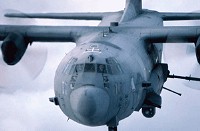 |
|
 |
|
| - What's New
- About Chapter 108 - Contact Us - Calendar - Newsletters - Projects and Planes - Safety/Regulations - Scrapbook - Young Eagles - For Sale - Links - Home |
 History
of AC-130 Gunships History
of AC-130 Gunships
January 1999 Chapter Meeting by Tom Johnson.
The second part of the videotape was actual combat footage from a mission in Viet Nam. A gunship was engaging several pieces of road-building equipment. The AC-130 was being supported by several F-4 Phantoms. The Phantoms destroyed several anti-aircraft guns prior to the AC-130 beginning it's engagement. (At this point Tom began a slide presentation that I am trying to obtain a copy of. If I obtain a copy, I will post the material here.) The idea of a sideways-firing gun platform originated during the Viet Nam war. The initial gunships were often cast-off aircraft with a fixed mini-gun. The Air Force tried many aircraft including the C-47 "Gooney Bird" as gunship platforms. The gunsips in Viet Nam became known as "Puff the Magic Dragon" due to their lethality and the immense amount of smoke generated by the mini-guns. Targeting systems on early gunships were very primitive. The aircraft would circle the target and the pilot would "aim" the guns by banking the aircraft. Needless to say, this system was rather inefficient and a fire control system was eventually added. Over the years the number and types of weapons on gunships have dramatically improved. Early gunships had only two fixed mini-guns. Current gunships have a mini-gun, 20mm Gatlin gun, and a 120mm cannon. The fire control systems have improved, too. Modern gunships have infrared, radar, and television aiming systems. Gunsips are now pressurized to allow operation at altitudes above 10.000 ft to avoid anti-aircraft artillery. For more information on AC-130 Gunships, check out the Air Force AC-130 Spectre fact sheet. |